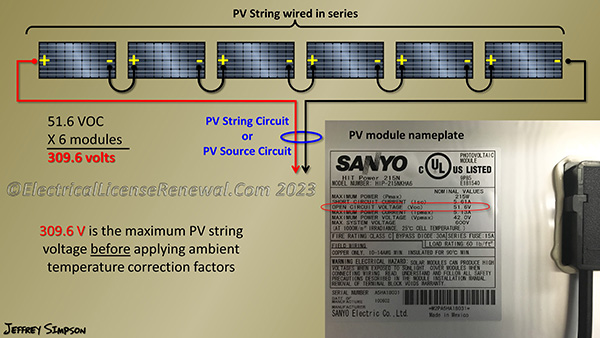690.7 Maximum Voltage.

Code Change Summary: Updated language on PV system voltage requirements.
In the 2023 NEC®, the language on calculating the maximum PV system voltage in Section 690.7(A) was updated to include reference to the “PV string circuit”. This aligns with the new definition of a PV String Circuit in Article 100, and the deletion of the term “PV Output Circuit”.
The following revised language makes it clear that there are two acceptable options to calculate the maximum PV system voltage for PV systems having an inverter generating capacity less than 100kW:
- Use the sum of the PV module–rated open-circuit voltage of the series-connected modules in the PV string circuit corrected for the lowest expected ambient temperature using the open-circuit voltage temperature coefficients in accordance with the instructions included in the listing or labeling of the module.
- For crystalline and multicrystalline silicon modules (most common), use the sum of the PV module–rated open-circuit voltage of the series-connected modules in the PV string circuit corrected for the lowest expected ambient temperature using the correction factors in Table 690.7(A).
Note that when wiring PV modules in series the open circuit voltage (VOC) from the PV module nameplate is additive while the short circuit current (ISC) from the PV module nameplate remains the same, and when wiring in parallel the current is additive while the voltage remains the same.
Also keep in mind that many PV system designs specify DC-to-DC Converters (some manufacturers call them power optimizers) which are able to provide an output dc voltage and current at a higher or lower value than the input dc voltage and current produced in the PV string circuit.
When DC-to-DC converters are specified, along with the appropriate inverter required in the instructions for the dc-to-dc converters, calculating the maximum PV system voltage based on the recommended number of PV modules specified in the dc-to-dc converter literature will often result in what appears to be a maximum overall PV system dc voltage far in excess of the maximum voltage levels permitted in 690.7(1) or (2).
If the dc-to-dc converter is doing its job then even if the string circuit voltage calculation results in what appears to be well over 600 volts for a one- or two-family dwelling (in violation of 690.7(2)), then technically between the combination of the dc-to-dc converters and the specified inverter, the entire PV system should never see more than 600 volts and would be considered to comply with the voltage threshold in 690.7(2).
PV system designs using multiple series connected DC-to-DC converters typically rely on the installation instructions when determining the maximum number of PV modules that can be connected in series without exceeding the voltage threshold specified in 690.7(1) and (2). Unfortunately, the installation instructions often fail to include a method to determine the maximum voltage once two or more series-connected dc-to-dc converters are used.
Section 690.7(B)(2) specifies that the maximum determined voltage shall be the sum of the maximum rated output voltage of the dc-to-dc converters in series if the instructions do not provide a “method” to determine the maximum voltage.
Below is a preview of the NEC®. See the actual NEC® text at NFPA.ORG for the complete code section. Once there, click on their link to free access to the 2023 NEC® edition of NFPA 70.
2020 Code Language:
690.7(A) Photovoltaic Source and Output Circuits. In a dc PV source circuit or output circuit, the maximum PV system voltage for that circuit shall be calculated in accordance with one of the following methods:
(1) The sum of the PV module–rated open-circuit voltage of the series-connected modules corrected for the lowest expected ambient temperature using the open-circuit voltage temperature coefficients in accordance with the instructions included in the listing or labeling of the module
(2) For crystalline and multicrystalline silicon modules, the sum of the PV module–rated open-circuit voltage of the series-connected modules corrected for the lowest expected ambient temperature using the correction factors provided in Table 690.7(A)
2023 Code Language:
690.7(A) Photovoltaic Source Circuits. The maximum dc voltage for a PV source circuit shall be calculated in accordance with one of the following methods:
(1) The sum of the PV module–rated open-circuit voltage of the series-connected modules in the PV string circuit corrected for the lowest expected ambient temperature using the open-circuit voltage temperature coefficients in accordance with the instructions included in the listing or labeling of the module
(2) For crystalline and multicrystalline silicon modules, the sum of the PV module–rated open-circuit voltage of the series-connected modules in the PV string circuit corrected for the lowest expected ambient temperature using the correction factors provided in Table 690.7(A)